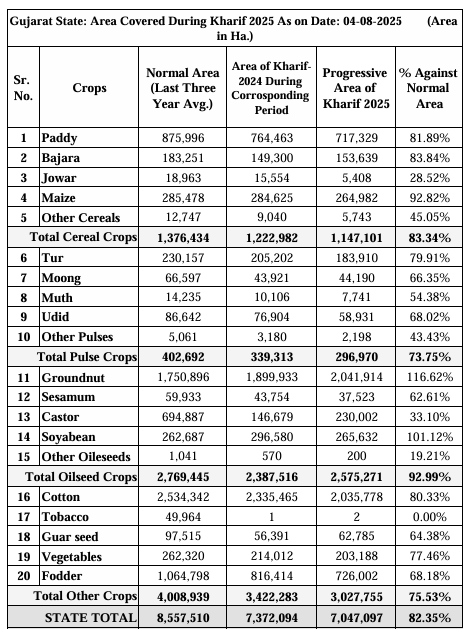Kharif sowing 2025 in Gujarat so far: Groundnut area surpasses Cotton
August 04, 2025
Gandhinagar: As of today, August 4, 2025, Gujarat has covered a total of 70.47 lakh hectares under various Kharif crops, which is 82.35% of the state’s normal Kharif sowing area of 85.57 lakh hectares. However, this is progressive data, as the monsoon—which made its onset in Gujarat on June 16—is ongoing, and the sowing of several crops is still underway.
According to official data so far, oilseed crops have shown a robust sowing trend, with groundnut exceeding the normal area by 16.62%, covering over 20.41 lakh hectares. Notably, groundnut sowing has also surpassed cotton sowing, which has so far reached 20.35 lakh hectares. However, since sowing is still continuing in some areas, it remains to be seen which of these two crops will ultimately have the highest sown area.
Furthermore, as of today, only two crops have witnessed an increase in acreage compared to their normal area: groundnut and soyabean. Soyabean has covered 2.65 lakh hectares, which is 101.12% of its normal area.
Overall, total oilseeds have been sown across 25.75 lakh hectares, achieving 92.99% of the normal area.
Among cereals, maize has covered 2.64 lakh hectares (92.82%), bajra 1.53 lakh hectares (83.84%), and paddy 7.17 lakh hectares (81.89%). However, jowar trails significantly, with only 5,408 hectares sown—just 28.52% of its normal area.
In pulses, sowing has reached 2.96 lakh hectares, or 73.75% of the normal area. Major contributors include tur (1.83 lakh hectares, 79.91%) and udid (58,931 hectares, 68.02%).
Other crops like guar seed (62,785 hectares, 64.38%) and vegetables (2.03 lakh hectares, 77.46%) also continue to progress steadily.
Meanwhile, among the top five districts with the highest sown area, Surendranagar leads with an impressive 5,51,900 hectares, followed closely by Amreli with 5,49,600 hectares and Kutch with 5,41,100 hectares. Rajkot, with 5,09,000 hectares, and Banaskantha, with 4,64,600 hectares, also remain among the top five. Together, these districts account for a significant share of the state’s total Kharif cultivation, underscoring their vital role in Gujarat’s agricultural landscape. DeshGujarat
Recent Stories
- India vs SL Match
- Free rides on AMTS buses for three days during Diwali
- 100 years of service to nation was our duty, so no celebration is needed: RSS Chief
- Commonwealth Sport Board Recommends Ahmedabad as Host City for 2030 Commonwealth Games
- Gujarat CM to visit Mumbai for listing of SMC's green municipal bonds on NSE


